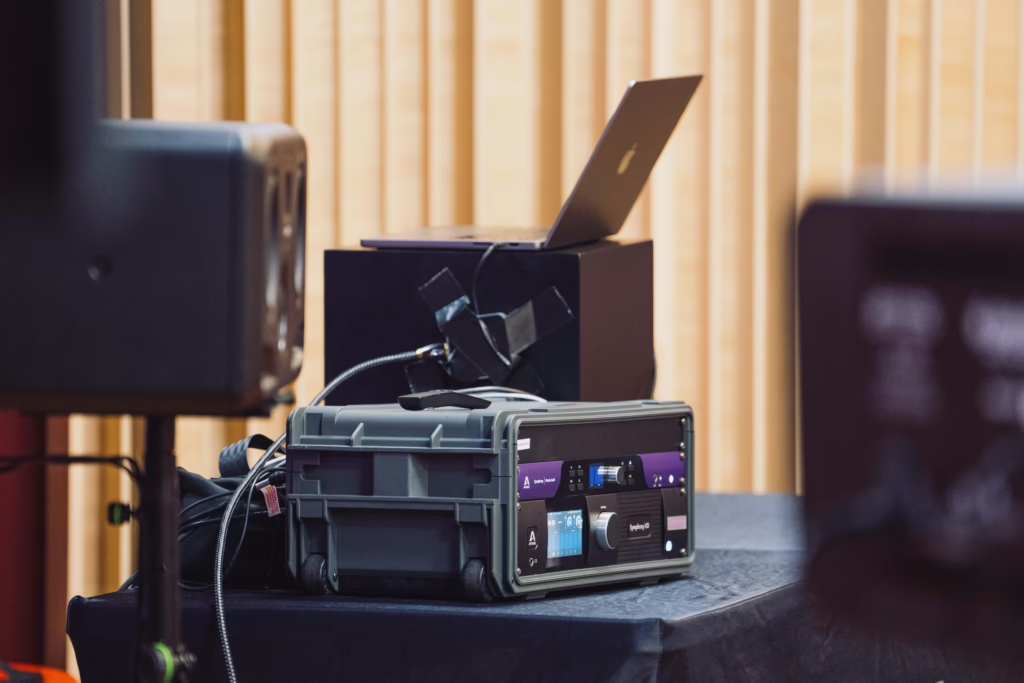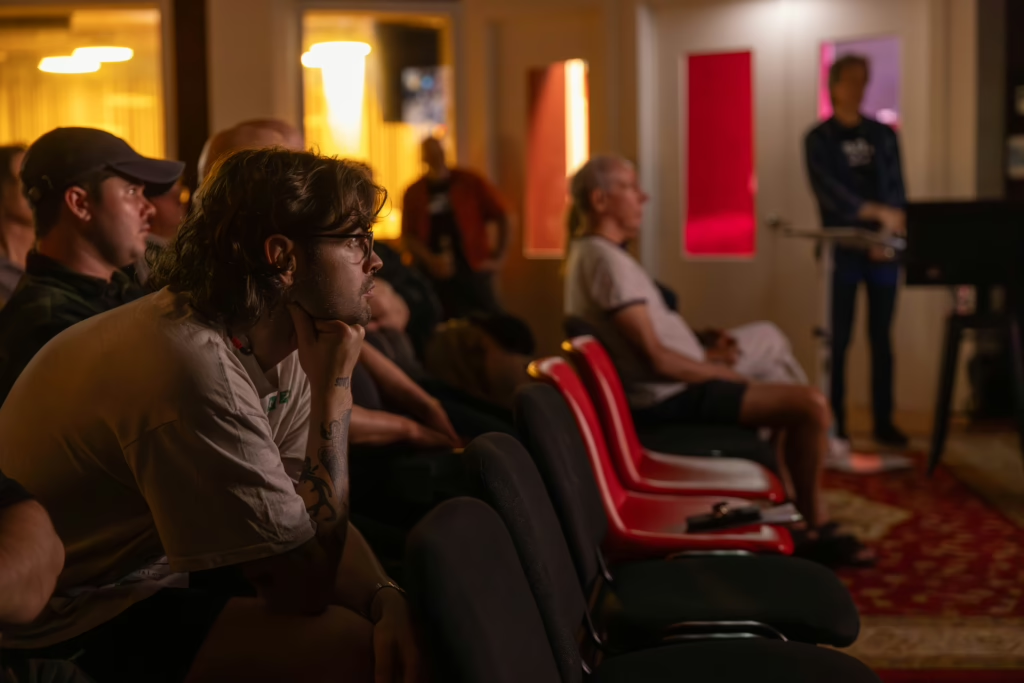Artists, Event Reviews, Software
The Art of Atmos with Bob Clearmountain
Bob finds the 'soul between the speakers' on new Masterclass series.
by Paul French

Get mutech updates in your inbox
Whether we are aware of it or not, we are currently in the midst of a watershed moment, not just for Dolby Atmos but for Immersive Audio in general.
In the thirteen years since its initial inception we have seen Atmos go from being an often misunderstood cinematic oddity, to a streaming service requirement and bonafide industry standard, the likes of which is unlikely to be surpassed anytime soon.
But beyond the guttural depth charges and hard panned SFX bending around a beguiled cinema audience, there is one corner of the audio community that has been somewhat hesitant in jumping neck deep into the Dolby Atmos format…..that is until now.
With streaming giants such as Apple music now requiring Atmos versions of musical works for their platforms, we are seeing mixing for Dolby Atmos become more of a priority for musically inclined engineers. Combine this with relatively recent technologies like Avid’s Dolby Renderer and the presence of binaural fold down of Atmos on most major DAWS (not to mention the various Atmos adjacent calibration softwares currently on offer by the major monitor manufacturers), never before has Dolby Atmos been more accessible and enticing to the musically inclined.

Perhaps one of the biggest champions of the Atmos format (and its musical application) is none other than legendary mix engineer Bob Clearmountain, who was recently down in Australia for a series of Atmos Mixing masterclasses (courtesy of recording hardware giant, Apogee).
Perhaps more so than any other engineer of his era, Clearmountain’s new found affinity for the creative possibilities afforded by Dolby Atmos makes a tonne of sense when we think about his career at the technical level.
As a mix engineer who cut his teeth working in NYC’s iconic Power Station studio in the late 70s, Clearmountain was an influential figure in an extremely fertile period in the history of recorded sound.
Gaining early recognition as both a tracking and mix engineer for disco music pioneers like Chic and Sister Sledge, Clearmountain knew exactly what was required in terms of marrying clean isolated rhythm tracks with full band exuberance in the open air and it was this style of production that would continue to influence so many of his classic productions, with his credits extending to everything from David Bowie’s ‘Let’s Dance’ to The Rolling Stones’s ‘Start me Up’, right through to Springsteen’s ‘Born in the USA’ and even INXS’ landmark Australian classic, ‘Kick’.
Rest assured if it is from the late 70’s or early 80’s and it both rocks and slaps in equal measure, there is a good chance that Clearmountain had a hand in its production and it is this perfect balance of rhythm and energy, of isolation and bleed, that makes his work such an ideal candidate for the Atmos treatment.

The masterclass begins with Bob playing and sharing with us a story of his time recording Bryan Adams’ 1984 hit ‘Run to You’. The results are both surprising and startling.
Having been brought up on the slick radio version of the track, it is interesting to note how in this case Atmos has brought out the raw, ‘punkiness’ of certain sounds typically buried within the stereo mix. Of particular note is the out of time, metallic delay on the snare, something which is indistinguishable from the other delays and reverbs in the original mix, but which plays a prominent role in the Atmos mix.
‘That hard panned delay you hear in the back left, that’s literally just a mic we had out in the loading bay. It’s the sound of the snare bouncing off a roller door’ remarks Bob as the song builds up to another big chorus, clanging snare delay and all.
Listening to Bob share these stories of ramshackle recording methods for major, big budget productions is an interesting exercise in the demystification of the tracking process, at least as it pertains to the golden age of multitrack recording. I mean for many of us, this era of recording and the music that it birthed is in many ways the height of corporate professionalism in the music industry. To hear that there was still this level of freedom and experimentation allowed in the recording of a Bryan Adams record, is somewhat inspiring.
Given the recent advancements in Dolby Atmos adjacent hardware and software (and the ever lowering cost of entry), one can only think that perhaps there is something similar on the horizon for Dolby Atmos in the musical realm, as more fresh blood enters the fold and the technology is liberated from the top end of town, becoming more portable and accessible to the everyperson in the process.
Now granted, ‘Portability’ and ‘Dolby Atmos’ are probably two words you never thought you would hear in the same sentence, but the amount of sheer scalability and I/O flexibility crammed into the diminutive 1U chassis of Bob’s interface of choice, the Apogee Symphony Studio 8×16, makes it a ideally suited for this kind of small scale Atmos application, especially when we consider that this rig will be toured along Australia’s East Coast for these various Masterclass events.
With two headphone ports, eight mic/line inputs and 16 analogue outputs via the D-SUB output at the rear, not to mention Apogee’s powerful Control 2 software, allowing for in the box calibration and control of 8 Apogee Monitor Workflows, as well as support for two subwoofers-it’s very much a recording interface that caters to multiple mixing formats beyond just traditional stereo. Suffice to say, the audio quality of Apogee’s renowned conversion still reigns supreme. Everything we hear during the session is rich, detailed and above all else, open-in a way which allows for extremely clear imaging in the immersive field, thanks in no part to the awesome 7.1.4 setup courtesy of ADAM Audio. Featuring four ceiling mounted A7V’s for experimental panning and no less than two ADAM Audio Sub 12’s providing the low end thump required to glue these seemingly diasporate compositional elements together, the choice and calibration of the monitoring chain was as much of a masterclass in touring Dolby Atmos, as the final mixes were in bringing this hardware to life.
Nowhere is the quality of this setup more apparent than in Clearmountain’s Dolby Atmos remix of Bob Marley and the Wailer’s 1978 classic ‘Is This Love’, a project he says was undertaken ‘just for a bit of fun…. maybe one day Bob’s record label will put it out’.
The results are nothing short of astonishing and provide a perfect example of the symbiotic relationship between arrangement and immersive mixing. Perhaps more than anything else we have heard today, the inherent space and prominent centralised bass afforded by the original track almost sounds like it was specifically written to be remixed in Atmos, some 40 years later. Hearing it in this way, proved a genuinely moving experience for everybody in the room-a mix engineer’s eulogy to one of history’s great songwriters. It’s moments like this that really illustrate what can be achieved through Atmos mixing in the musical realm and the additional layer of expression that can be afforded through this level of control and placement.
As I scan the room during the 3:52 of ‘Is This Love’, it’s poignant to note that nobody is on their phone. My fellow media members have stopped scrawling notes and the various industry partners and studio representatives that have filled out the live room of Heidelberg’s Studio 52 have traded their subtle whispers for complete silence. Some have their eyes closed, others are looking at the different source speakers around the room, as sonic elements enter and leave the arrangement as it undulates through different sections of the familiar track. Each one of them is transfixed with what they are hearing.

In the world of music technology, where buzz words and marketing jargon are often thrown around like confetti, it can be that we hear a term so much that it starts to separate itself from its original intended application. In this moment however, what we are witnessing is the actual immersive quality of immersive audio in the musical context. A posthumous conversation between a legendary songwriter and a legendary mix engineer taking place decades apart- the tasteful, modern enhancement of a timeless piece of art and the heightened emotional power this can provide, beyond the technical capabilities of the original stereo track.
If you were wondering where the soul of Atmos lies, it’s not about more speakers. It’s about using technology to enhance listener experience and the kinds of genuine moments this can yield.